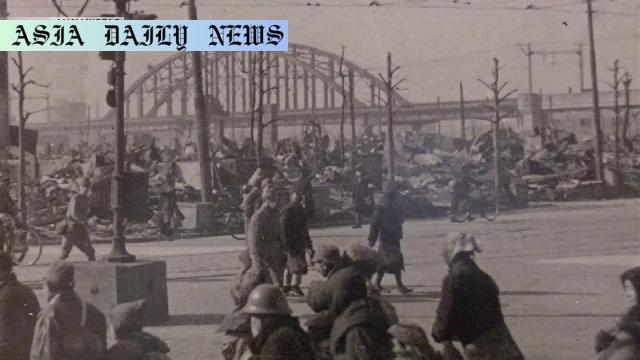Tokyo air raid – An exhibition in Sumida Ward showcases undisclosed images, drawings, and maps highlighting the 1945 bombing.
Key Point 1: Newly revealed photos of the 1945 Tokyo air raid are on display in an exhibition at Sumida Ward, Tokyo.
Key Point 2: The air raid killed approximately 100,000 and burned most of the area, with 53 exhibits including maps and survivors’ drawings.
Key Point 3: The exhibition aims to offer insights into the survivors’ experiences and runs through May 25, 2024.

Introduction: A Haunting Look into Tokyo’s History
The city of Tokyo is paying homage to a significant yet devastating chapter in its history through a new exhibition featuring previously unrevealed photos of the 1945 US air raid. The display, located in the Sumida Ward’s local history and culture museum, seeks to share untold stories and provide powerful visual insights into one of World War Two’s most tragic events.
Unveiling Forgotten Imagery
A local photo studio has provided a series of photographs never seen by the public until now. These images vividly depict the aftermath of the March 10, 1945, US air raid, which is estimated to have taken the lives of around 100,000 individuals. In addition to destroying countless lives, this catastrophic event scorched the majority of the area, leaving little but ashes and memories. One photograph, in particular, is thought to capture scenes close to burning houses in what is now southern Sumida Ward, presenting a harrowing view of the incident.
Diversified Media: Maps, Drawings, and Survivor Accounts
Beyond photographs, the collection extends to include a diverse range of materials. Survivors have contributed personal drawings, and several maps elucidate the broader scope of the event. These multimedia exhibits aim to enhance understanding not only of the event’s logistics but also of the sheer emotional toll witnessed by survivors. The goal is to ensure the viewer connects with the realities faced by ordinary citizens during the bombings.
Historical Reflection and Learning
Ishibashi Seishi, the exhibition’s curator, emphasizes the importance of being able to connect visual materials with testimonies. By doing so, visitors gain access to a stronger narrative that transcends dry historical facts, facilitating a greater appreciation of the gravity of past events. Insights drawn from this exhibition can be instrumental in fostering awareness about Japan’s history and promoting peace-driven efforts globally.
Honoring the Lost and Inspiring the Future
The timing of the exhibition is symbolic, arriving ahead of the 80th anniversary of the air raid. Running until May 25, it gives visitors ample opportunity to delve deeply into Japan’s wartime history. Each photo, drawing, and map intends to convey a message that transcends time: remembrance, resilience, and reconstruction. This is not just an exhibition but also an act of honoring those who endured unimaginable hardships and those who lost their lives during the raid.
Looking Beyond the Horrors
The exhibition invites reflection on the broader implications of warfare. While the extent of annihilation in Tokyo is undeniable, it also highlights the resilience of humanity. Cities can be rebuilt, and lives can move forward—but the lessons learned from such horrors must never be forgotten, lest history repeats itself. Such events provide critical impetus to global peace efforts and the discussion on the human cost of military actions.
Conclusion: A Must-Visit Exhibition
For its rare and thought-provoking insights, the exhibition at Sumida Ward is a must-visit for anyone interested in history, culture, or humanity’s collective journey through wartime struggles. The event successfully bridges the gap between memory and learning, ensuring that the tragedies of the past are not only acknowledged but also leveraged to foster a more informed, compassionate future.



Commentary
The Power of Visual Storytelling
The newly unveiled photos and other exhibits allow us to connect with a critical yet painful historical event in an intimate way. Imagery, especially when coupled with survivor testimonies, can evoke emotions and thoughts that a simple list of facts cannot. The photographs bring into focus the immeasurable human suffering experienced by those during the Tokyo air raid, making history tangible and real for modern audiences.
The Importance of Reflecting on History
Exhibitions such as this one serve as stark reminders of the cost of war. The sheer destruction captured in these images should not just evoke sorrow but also reflection. They offer a pathway to understanding the consequences of conflict and provide a platform for discussions about peace and reconciliation. Without acknowledging these truths, we risk repeating the mistakes of the past.
From Tragedy to Legacy
What makes this particular exhibition so meaningful is its commitment to honoring the lost while inspiring the living. Sumida Ward’s museum has succeeded in transforming a tragedy into an educational opportunity. By connecting personal stories, visual evidence, and historical analysis, it has turned a painful chapter of Tokyo’s past into a tool for understanding, advocacy, and growth. Such initiatives deserve applause for their value in deepening public awareness and compassion.